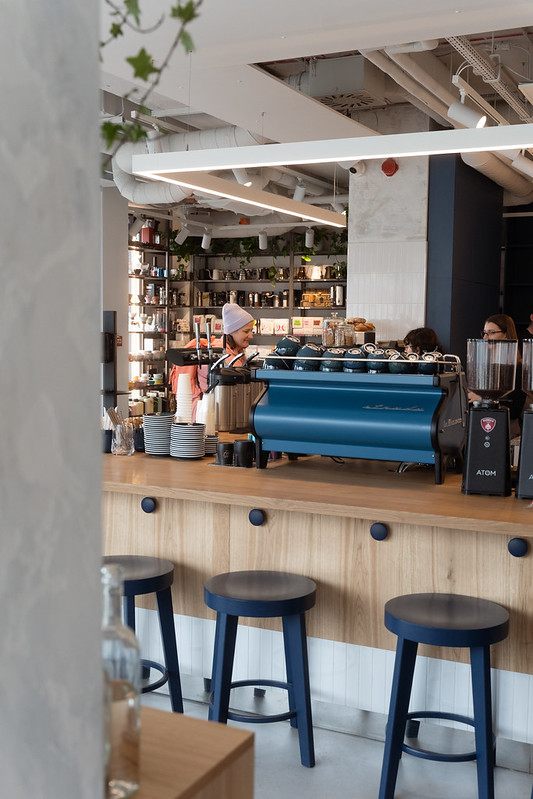Coffee is one the most popular non-alcoholic beverages in the world, appreciated for its aroma and caffeine content. The world coffee market was valued at $ 107,98 billion in 2021, and the predicted CAGR growth for 2022-27 is 7.6%. Those calculations are based on the observed increase in the number of coffee consumers in cafés, rapid urbanization and rising retail e-commerce sales.

Coffee at a Global Level
Today coffee is cultivated in over 70 tropical or subtropical countries and it is consumed all over the world. World leaders in coffee production are: Brazil, Vietnam and Columbia. However, as new generation of Columbian farmers is practically non-existent, China will soon take over, as their production of green coffee beans is constantly speeding up.
The market is propelled by a lot of factors, including greater awareness of better quality coffee and increasing demand for it, as well as innovations in this segment. Over the last couple of years it has become obvious that consumers are more and more interested in the origin and processing of the products they buy. In the developing economies it is expected that consumers will replace instant coffee with more advanced, quality options.

How Do the Europeans Take Their Coffee?
It’s hard to believe that anyone drinks more coffee than the Americans with their Starbucks, McCafé, or Dunkin’ Donuts chains. However, considering coffee consumption per resident, the USA lags behind European countries.
While coffee culture originated in the Middle East in the 15th century, and the Italian espresso bar or the Parisian café are often the first that come to mind when you consider the ethnicity of coffee consumers, none of these is at the top of the per-person coffee consumption chart. So, what can you expect? What can you say about the countries most famous for their love for coffee?

1. Finland is the largest coffee consumer on a per-person basis in the world. The average Finn drinks about 10 kilograms of coffee per year, which means about 4 cups of coffee per day! The Finns drink coffee mainly at home and at work. It is believed that the tight-knit relationship of the Scandinavians with caffeine is so strong due to dark and harsh winters.
The Finns drink light roast coffee brewed in a traditional Finnish way, which is a combination of Turkish coffee (where water and ground coffee are boiled multiple times) with pour-over brewing methods.
2. Norway, like Finland, is a land flowing with light roast pour-over coffee. It is traditionally served with every meal, but unlike their neighbours, Norwegians spend more time in cafés, where they can have a sweet dessert with their favourite beverage. Norway is home to some of the best specialty roasteries and cafés.
3. Coffee popularity in Iceland is connected with the ban on beer consumption (in place for the most part of the 20th century) and high prices of wine, which led to finding another beverage that would accompany social events. There’s a long-standing tradition of drinking coffee in coffee houses, so Iceland has a lot of local independent cafés.

4. In Denmark there is a word, kaffeslabberas, which describes an informal social gathering over coffee and some cake. The Danes drink mostly black coffee, often filtered. In bigger cities you can drink coffee basically everywhere, even at the laundromat, where you can have an espresso while waiting for your laundry to be ready.
5. The Netherlands played a big role in popularizing coffee in Europe through coffee shrub cultivation in Dutch colonies at the Pacific Islands already in the 17th century. Coffee is an integral part of life in Holland – you can buy it everywhere and there are no rules for how to take your koffie. The most popular is black or with a splash of warm milk.

What Can You Learn from the Polish Stats?
According to the INSE Research report on coffee market from 2020, over 80% of the Poles drink coffee regularly and 60% drink it every day. In the world charts we hold the 11th place, with slightly above 2 kg of coffee consumption per person annually. We usually drink our coffee at home or on the go – most of us can’t imagine even one day without coffee!
Statistically, most of us pour hot water over regular ground coffee or instant coffee at home, although quite a lot of the Poles use espresso machines or filter coffee machines. It turns out that the espresso machine market in Poland is the 3rd largest in Europe, right after Germany and France. It directly influences the upsurge in coffee beans sales, which grows year by year.
Development of Specialty Segment in Poland
More and more people are interested in alternative brewing methods and top-quality specialty coffees. The reason and the result of this phenomenon are Third Wave cafés, which are opening at a rapid pace (especially in large cities). From the beginning they thought education was key and it paid off. Social media played a huge part in the transformation – responsible trade, competitions and coffee events, healthy zero waste practices and vegan menus – all that helped them exist and shine at the coffee arena that hadn’t changed for years.

Coffee market in Poland is very receptive and rapidly developing area, which needs creative approach and responding to the global trends. Specialty cafés have a particular range of possibilities and they should respond to the developing needs of customers in a clever way – you can read more about post-pandemic requirements and trends here.





